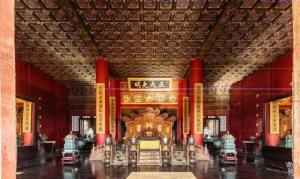Why was the Forbidden City built?
The Forbidden City in Beijing, as a treasure of Chinese civilization, is undoubtedly a great wonder in the history of world architecture. This huge building complex, more than 900 meters long from north to south, more than 700 meters wide from east to west, surrounded by a 10-meter high wall, there is a wide moat outside the wall, a total area of more than 720,000 square meters, construction area of nearly 150,000 square meters. There are more than 70 palaces and thousands of houses in the Forbidden City, which is one of the largest and best preserved ancient wooden structures in the world.
Since its completion in the 18th year of Yongle of the Ming Dynasty, the Palace Museum has not only been the administrative center and residence of the emperors of the Ming and Qing dynasties, but also witnessed the splendor and desolation of the 24 generations of emperors from Zhu Di to Pu Yi, the last emperor of the Ming Dynasty. The center of the Forbidden City, the central axis of Beijing, in accordance with the regulation of the ancient “front and back sleeping”, is arranged with the three main halls where the emperor held grand ceremonies – the Hall of Supreme Harmony, the Hall of Central Harmony, and the Hall of Preserving Harmony, and the last three palaces where the emperor’s concubines lived – the Palace of Dry Qing, the Hall of Communication and Tai, and the Palace of Earthly Tranquility.

After the Revolution of 1911, according to the preferential treatment Regulations of the Qing Dynasty, Puyi and his royal family members were still able to live in the Imperial Palace. However, with the change of history, in 1924, Feng Yuxiang launched the “Beijing Coup” and expelled Puyi from the palace. In 1925, the Palace Museum was officially opened to the public and became a museum for people to visit. After the founding of the People’s Republic of China, the Palace Museum was renovated on a large scale and a large number of cultural relics were sorted out.
In 1961, the Forbidden City was listed as a national key cultural relic protection unit by The State Council. Today, the Palace Museum has a collection of more than 1.5 million cultural relics. In 1987, the Forbidden City was listed as a World Cultural Heritage by UNESCO. Along with the Kremlin in Russia, the Palace of Versailles in France, Buckingham Palace in the United Kingdom, and the White House in the United States, it is known as one of the five major palaces in the world.
The construction of the Palace Museum began in the fourth year of Yongle and was completed after 14 years. During this long period of time, a large number of craftsmen, civilians and soldiers were used to participate in the construction. The reason why Zhu Di went to great lengths to build this huge palace was not only to highlight the majesty of imperial power, but also out of far-reaching political and military considerations. The completion of the Palace Museum not only reflects the brilliance of the Ming Dynasty, but also becomes a treasure of Chinese civilization, leaving a valuable cultural heritage for later generations.
In fact, in addition to Chang ‘an and Luoyang, the former capital of the Han and Tang Dynasties, Zhu Yuanzhang had another choice: Dadu (today’s Beijing) of the Yuan Dynasty. In fact, Beijing at this time was more strategically valuable than Chang ‘an and Luoyang. Why has no dynasty capital been established in Chang ‘an or Luoyang since the Tang Dynasty? One important reason is that Chang ‘an and Luoyang declined with the southward shift of China’s economic center after the Anshi Rebellion. But since the centre of economic gravity is moving south, why not simply move the capital to the south? The biggest foreign aggression in ancient China was the nomads in the north. If the capital was fixed in Jiangnan, it would almost mean a devastating disaster for the northern frontier defense.